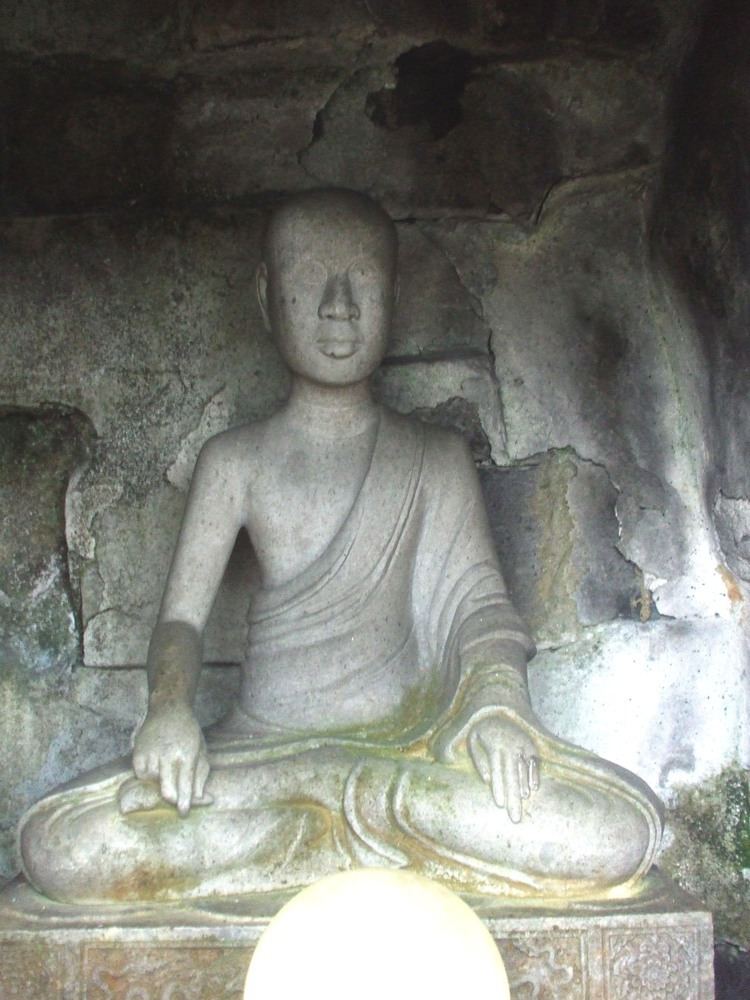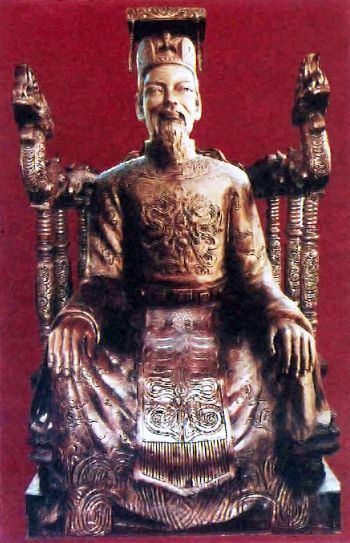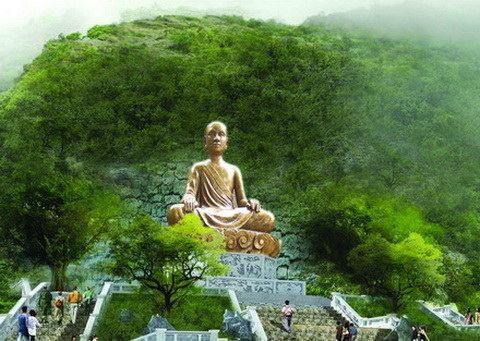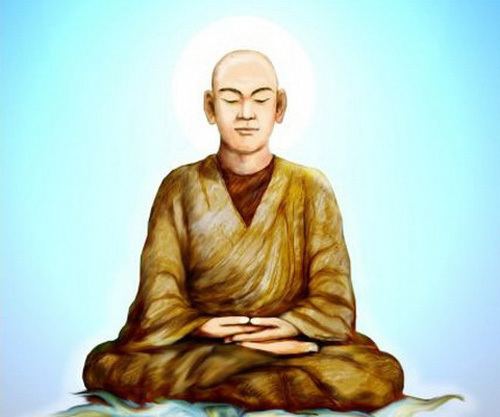Reign 1278–1293 Predecessor Tran Thanh Tong Predecessor Tran Thanh Tong Successor Tran Anh Tong | Successor Tran Anh Tong Name Tran Tong Reign 1294–1308 | |
 | ||
Điều Ngự Giác hoàng Trần Nhân Tông - Đức Phật của người Việt
Trần Nhân Tông (7 December 1258–16 December 1308), given name Trần Khâm, was the third emperor of the Trần dynasty, reigning over Đại Việt from 1278 to 1293. After ceding the throne to his son Trần Anh Tông, Nhân Tông held the title Retired Emperor (Vietnamese: Thái thượng hoàng) from 1294 to his death in 1308. During the second and third Mongol invasions of Đại Việt, the Emperor Nhân Tông and his father the Retired Emperor Thánh Tông were credited as the supreme commanders who led the Trần dynasty to the final victories and since established a long period of peace and prosperity over the country.
Contents
- iu Ng Gic hong Trn Nhn Tng c Pht ca ngi Vit
- Background and during Thnh Tngs reign
- Mongol invasions
- After the war
- Family
- Legacy
- References
Background and during Thánh Tông's reign
Trần Nhân Tông was born on November 11 of the lunar calendar 1258 as Trần Khâm, the first son of the Emperor Trần Thánh Tông, who had been ceded the throne by Trần Thái Tông for only eight months, and Empress Thiên Cảm Trần Thị Thiều. It was said that the newborn Trần Khâm was so fine that his grandfather Thái Tông and father Thánh Tông named him as Kim Tiên đồng tử (Pupil of the Heavenly Kim Tiên). Prince Trần Khâm was entitled as Crown Prince of the Trần dynasty in December 1274, he had a younger brother, Prince Tá Thiên Trần Đức Việp (born in 1265) and an elder sister, Princess Thiên Thụy, who would die on the same day as her brother Nhân Tông. Always concerned with the education of his son, in 1274, Trần Thánh Tông appointed the prominent mandarin and general Lê Phụ Trần in the position of the crown prince's professor with two famous scholars Nguyễn Sĩ Cố and Nguyễn Thánh Huấn as assistants, the Emperor himself also composed poems and a literary work named Di hậu lục to educate prince Trần Khâm.

On the 22nd of the tenth lunar month (November 5) 1278, Trần Thánh Tông decided to cede the throne to the Crown Prince Trần Khâm, now Trần Nhân Tông, and held the title Retired Emperor. After the coronation, Nhân Tông changed the era name to Thiệu Bảo (紹寶, 1278–1285), during his reign, the emperor had one more era name which was Trùng Hưng (重興, 1285–1293). Although passing the throne to his son, Thánh Tông continued to co-rule the country with Nhân Tông from 1279 to his death in 1290.
Mongol invasions

In 1279, the Yuan dynasty had the decisive victory over the Song dynasty in Battle of Yamen which marked the end of the Song dynasty and the total control of Kublai Khan over China. As a result, Kublai Khan began to expose his attempt to take over the southern countries like Đại Việt or Champa. Aware of the situation, Thánh Tông and Nhân Tông began to prepare the Trần dynasty for the obvious and inevitable war while tried to keep a flexible policy with the Yuan dynasty. First, Prince Chiêu Văn Trần Nhật Duật was appointed for the mission of pacifying the revolt led by Trịnh Giác Mật in Đà Giang by diplomatic means in order to keep the country in stability before the war. With his knowledge of minority people's language and culture, Trần Nhật Duật successfully accomplished his task in 1278, hence, the Trần dynasty had free hand to deal with the threat from the North. In October 1282, the Retired Emperor Trần Thánh Tông and the Emperor Trần Nhân Tông gathered all the members of the royal family, and officials in royal court in Bình Than to discuss about the unadvoidable war. Two prominent generals of Đại Việt's army were noticed on this occasion, Trần Khánh Dư, former commander of the army but was deprived of all titles after his guilt, and Trần Quốc Toản, only a 16-year-old marquis. In 1283, Prince Hưng Đạo Trần Quốc Tuấn was appointed as commander-in-chief (Quốc công tiết chế) of Đại Việt army, the Retired Emperor and the Emperor began to hold military exercises with their generals and troops.
In December 1284, the second Yuan's invasion of Đại Việt was opended under the command of Kublai Khan's prince Toghan. Đại Việt was attacked in two directions, Toghan himselft conducted the infantry invaded from the northern border while Yuan's navy under general Sogetu advanced from the southern border through Champa's territory. In the beginning of the war, Thánh Tông and Nhân Tông had to order the army retreat to avoid the pressure from Yuan's force when Prince Chiêu Minh Trần Quang Khải commanded troops try to stop Sogetu's fleet in the Nghệ An Province. During this time, there were several high-ranking officials and members of royal family of the Trần dynasty defected to Yuan's side including Thánh Tông's own brother, Prince Chiêu Quốc Trần Ích Tắc and Trần Kiện who was son of Prince Tĩnh Quốc Trần Quốc Khang. For the safeness of Thánh Tông and Nhân Tông's retreat, Princess An Tư was offered as present and diversion for prince Toghan while Marquis Bảo Nghĩa Trần Bình Trọng was captured and later killed in Battle of Đà Mạc in defending the two emperors. In the southern border, Trần Quang Khải also had to retreat under the pressure of Sogetu's navy and the defection of the governor of Nghe An. Despite the repeated problems, the royal family and royal court of the Trần dynasty still kept their harmony and determination owing to accurates decisions and actions from the leaders Thánh Tông, Nhân Tông, Trần Quốc Tuấn and Trần Quang Khải.

The critical situation of the Trần dynasty began to change after their victory in Battle of Hàm Tử in April 1285 where the troops commanded by Trần Nhật Duật, Prince Chiêu Thành, Trần Quốc Toản and Nguyễn Khoái were finally able to defeat the fleet of Admiral Sogetu. On May 10 of lunar calendar 1285, Trần Quang Khải fought the decisive battle in Chương Dương where Sogetu's navy was almost destroyed and therefore the balance in battlefield titled definitely in favour of the Trần dynasty. 10 days after Sogetu was killed and Trần's Emperor Nhân Tông and Retired Emperor Thánh Tông returned to capital Thăng Long on June 6 of lunar calendar, 1285.

In March 1287, the Yuan dynasty launched their third invasion of Đại Việt. Unlike the second attack, this time commander in chief Prince Hưng Đạo Trần Quốc Tuấn affirmed with the Emperor that Đại Việt's army could easily break the Yuan's military campaign. Indeed, this invasion was ended one year later by a disastrous defeat of the Yuan navy in Battle of Bạch Đằng on March 8 of lunar calendar, 1288. Besides Trần Quốc Tuấn, other notable generals of the Trần dynasty during this time were Prince Nhân Huệ Trần Khánh Dư who destroyed the logistics convoy of Yuan navy in the Battle of Vân Đồn or general Phạm Ngũ Lão who took charge of ambushing prince Toghan's retreating troops.
After the war
In rewarding Trần dynasty generals and mandarins after the victory, Thánh Tông and Nhân Tông also reminded them of the caution to the northern border. About the defectors to Yuan side, the Emperor issued an order in which the family name of every defected member of Trần clan was changed to Mai, for example Trần Kiện was renamed as Mai Kiện, being the only defected prince of Trần clan, Trần Ích Tắc was exempted from this order but he was called in historical accounts of the Trần dynasty by the name "Ả Trần" ("the woman named Trần") meaning that Trần Ích Tắc was "coward as a woman".

The Retired Emperor Trần Thánh Tông died on May 25 of lunar calendar, 1290 at the age of 50. As the sole ruler of Đại Việt, Trần Nhân Tông ordered to relax the taxing policy, relieve the poor and postpone the military campaign against Ai Lao so that the country could recover after two fierce wars, several famine and natural disasters.
On February 3 of lunar calendar, 1292, Nhân Tông entitled his first son Trần Thuyên as Crown Prince of the Trần dynasty and finally decided to pass the throne to him on March 3 of lunar calendar, 1293.
As a cloistered emperor, Trần Nhân Tông is revered as a wise Buddhist sage who founded Trúc Lâm, the only indigenous Thiền (i.e. zen) sect. He is thought to have attained Buddhahood.
In 1301, he visited Champa, and lived for nine months at Jaya Sinhavarman III's court.
In 1306, he gave his daughter, Princess Huyen Tran, in marriage to the Champa king Jaya Simhavarman III, in return for two Cham provinces.
Family
Trần Nhân Tông married Princess Khâm Từ, later Empress Consort Khâm Từ Bảo Thánh, the eldest daughter of Prince Hưng Đạo Trần Quốc Tuấn, in December 1274 when he was entitled as crown prince. Trần Nhân Tông had his first son, Trần Thuyên, on September 17 of lunar calendar, 1276, Trần Thuyên eventually became Nhân Tông's successor as Trần Anh Tông.
Legacy
Most cities in Vietnam have named major streets after him.
